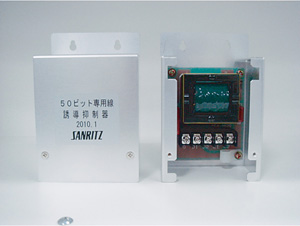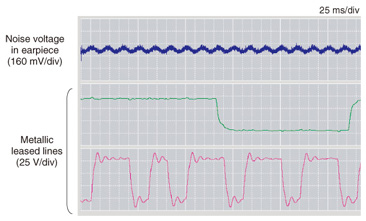 |
||||||||
|
|
||||||||
|
Practical Field Information about Telecommunication Technologies Vol. 11, No. 2, pp. 58–63, Feb. 2013. https://doi.org/10.53829/ntr201302pf1 Case Study of Noise Faults Originating in Metallic Leased Lines and CountermeasureAbstractIn this article, we introduce failure cases and a failure countermeasure for metallic leased lines. This is the fifteenth in a bimonthly series on the theme of practical field information on telecommunication technologies. This month's contribution is from the Network Service Engineering Group, Technical Assistance and Support Center, Maintenance and Service Operations Department, Network Business Headquarters, NTT EAST. 1. IntroductionThe communications network is becoming increasingly faster thanks to higher capacities in the transit network and the conversion to optical fiber in the access network. In the home, meanwhile, LAN (local area network) environments using gigabit network interfaces are growing in number. This trend can also be seen in telecommunication services, where customers can get speeds of several tens of gigabits per second over wide-area Ethernet leased lines for business use [1] and a maximum speed of 200 Mbit/s on the downlink via the FLET’S HIKARI NEXT broadband service for home use [2]. In short, the NTT Group provides various high-speed communication services. What is probably not well known, however, is that it continues to provide leased-line services at the very slow speed of 50 bit/s over metallic lines. Needless to say, it is impossible to transmit large volumes of data at this speed, but these metallic leased lines are still being widely used for various applications such as remote monitoring of water-supply facilities, the transmitting/receiving of information in river management, and the transmitting of telemetric data. The position of metallic leased lines among telecommunication services provided by NTT EAST and NTT WEST is shown in Fig. 1.
2. Overview of metallic leased linesAs circuits that can provide dedicated data transmission at speeds up to 50 bit/s by a direct-current (DC) method, metallic leased lines can be configured using an earth-return or metallic-return system (Fig. 2). The earth-return configuration enables full-duplex, bidirectional communications for transmission and reception using a single-pair cable (L1/L2: lines 1 & 2). The metallic-return configuration, on the other hand, can be used for either unidirectional or half-duplex communications. The pulses transmitted by communication devices used for metallic leased lines are of the DC type with a maximum voltage of 50 V. More technical details about analog leased lines are given on the NTT EAST website [3].
3. Metallic leased lines and noise faultsIn the metallic-return system, the L1 and L2 lines are used as outward and homeward paths for the same signal, which means that the voltage induced in neighboring circuits is low. In the earth-return system, however, different signals flow through L1 and L2; this results in a high induced voltage that can generate noise faults in neighboring circuits. These noise faults include mixing of noise in analog circuits and communication anomalies in metallic leased lines and in 3.4-kbit/s leased lines within the same cable. Thus, metallic leased lines are sources of noise that can affect other circuits within the same cable and give rise to various anomalies. The next section presents a case study of noise faults caused by metallic leased lines and describes the countermeasure applied. 4. Case study of noise faults and countermeasure4.1 Fault description and inspection resultsA waterworks bureau that manages communications between a purification plant and multiple pumping stations using analog leased lines (3.4-kbit/s leased lines and metallic leased lines) reported that communication anomalies were occurring from time to time in terminals on the purification-plant side. In order to switch the leased lines generating the communication anomalies to other core wires in the same cable, the fault-repair department conducted a free-wire test, but the appearance of line-testing anomalies (induced voltage detected from nearby core-free wires) indicated that many core wires could not be used. The facility configuration is shown in Fig. 3.
4.2 Inspection methodWhen the cable extending from the purification plant was checked, it was found that the cable accommodated 20 circuits of metallic leased lines using the earth-return system. Therefore, voltage-to-ground measurements of metallic leased lines and free core wires were performed within that cable to see whether noise from metallic leased lines was being mixed into other circuits. The measurement results are shown in Fig. 4.
These results revealed that noise constantly fluctuating in the peak-to-peak voltage range up to 10 Vpp was being mixed into free core wires. This noise was thought to be causing the line-testing anomalies discovered by the fault-repair department. It was therefore inferred that noise was being induced from the 20 metallic-leased-line circuits in the same cable. In particular, the sections in Fig. 4 marked by broken lines indicate points in these waveforms where noise was thought to be synchronized with signals in the metallic leased lines. The cause-and-effect relationship between induced noise and signals in metallic leased lines is examined in detail in Fig. 5. The green and red waveforms indicate signals in metallic leased lines, and the blue waveform indicates the line voltage in the earpiece of a telephone connected to an analog circuit within the same cable. At this time, noise (sounding like “bootz, bootz”) could be heard from the earpiece. These waveforms showed that noise in free core wires was synchronized with the rise and fall of signal voltage in metallic leased lines.
4.3 Cause of faultThe results of the inspection described above led to the conclusion that the reported communication anomalies were caused by noise originating in metallic leased lines. This noise became mixed into other circuits within the same cable, resulting in communication anomalies in the 3.4-kbit/s leased lines and metallic leased lines and in line-testing anomalies in free circuits. 4.4 Countermeasure and resultsNoise filters commonly used as a countermeasure to noise mixing are not effective for noise originating in metallic leased lines. This noise can, however, be effectively controlled by applying the induction suppressor shown in Photo 1 to metallic leased lines. This device suppresses induction in other circuits by smoothing out sharp changes in the signal waveform of a metallic leased line.
The method of applying the suppressor in this case study is shown in Fig. 6. There was already a suppressor between the terminal and the NTT office. In this case study, additional suppressors were installed at two locations (purification plant and NTT office), since bidirectional communications were being carried out. The G pin on each induction suppressor was connected to the earth for communication purposes.
The signal waveforms after this countermeasure was applied to the metallic leased lines and the results of measuring noise at the telephone earpiece on an analog circuit are shown in Fig. 7. The rise and fall of signals in the metallic leased lines have been smoothed out, thereby eliminating sharp changes in those signals. As a result, no noise was observed mixing into the analog circuits.
5. ConclusionThis article introduced a case study of a noise fault in metallic leased lines and a countermeasure applied to correct it. NTT EAST and NTT WEST must continue to maintain existing metallic leased lines despite the current expansion of high-speed broadband services. The Technical Assistance and Support Center will continue to provide support for dealing with faults unique to metallic leased lines. References
|
||||||||
















